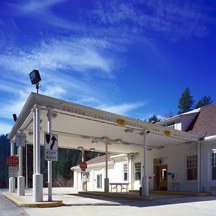Historic U.S. border inspection stations, 1931-1943
What Is a Border Inspection Station?
A border inspection station is a facility located at a United States point of entry where customs and immigration officers inspect vehicles and possessions of people entering the United States. These officers also review the documentation of individuals seeking legal entry into the country.
Where they are located: Along the southern and northern borders of the United States.
History: Form Follows Function
The earliest inspection stations, constructed between 1931 and 1943, are significant examples of the nation’s first purpose-built customs and immigration stations for land crossings.

Border Station
Tecate, California
Constructed 1933-1934
Supervising Architect: James A. Wetmore
National Register Listed
Prior to 1931, there were no dedicated land border inspection stations on American soil, only water ports of entry. Meanwhile, as car traffic expanded exponentially at land crossings, customs and immigration officials struggled. Those working at the northern and southern borders had to use existing structures poorly suited to customs and immigration tasks, including shacks and even tents. In some cases, agents couldn’t even use buildings, but actually performed their inspections in the open air, regardless of weather, while being ogled by locals. Many structures were located far from the borders, and agents struggled to direct unwilling drivers to these inconvenient locations.
These makeshift, embarrassing conditions led to loss of customs revenue, flouting of prohibition and immigration law, and poor employee morale.
Responding to a changing country: The creation of dedicated border stations reflected three significant changes in American culture: a shift in immigration law, the American love affair with the car, and Prohibition. The border stations were also an early example of data-driven planning: the buildings were designed after an extensive survey of immigration and customs officers, as well as informal and formal studies of traffic patterns. Demand drove both the placement and the size of the buildings.
Reflecting American diversity: Whenever possible, a border station reflected regional culture. Within the parameters of a building’s typology, a border station design took into account the region’s climate, geography, and history. These buildings were part of a larger movement in federal architecture to express the meaning and the strength of the federal government to its citizens, present and future.
For those entering into the United States for the first time, the border inspection station building was what Ellis Island and the Statue of Liberty were for those entering by water: the first symbolic expression of the United States and its values.
When and why does a border station of this era qualify as an “historic building?” Property types that retain their ability to convey historical associations, physical characteristics, and integrity are eligible for listing in the National Register of Historic Places. This includes some of the border stations highlighted in this section.
Please continue to learn more about historic border inspection stations:

 U.S. General Services Administration
U.S. General Services Administration

